Properly organized ventilation in a frame house is an important aspect for buildings of this type. The peculiarities of materials from the frame require a special approach to creating a ventilation system. Before installing, you need to study the rules and regulations, choose the appropriate type of system and deal with its nuances. You can also carry out step-by-step installation yourself, following the instructions.
The need for ventilation in a frame house
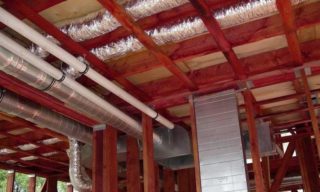
The walls of frame buildings are able to retain heat well inside the room and thereby reduce energy costs. This effect can be achieved thanks to the layer-by-layer installation of insulation, the use of materials with vapor barrier, interior and exterior details. The economy of this type also has its drawbacks, it provokes an increase in the level of humidity in the room, as well as incomplete removal of exhaust air from there.
The protective layer of the vapor barrier is able to retain condensate remaining inside the walls, accumulating it can ruin the insulation, decoration and frame, which begin to rot. A ventilation system in houses of this type is also necessary to prevent the accumulation of chemical vapors that are used to treat frame beams, straps and other elements inside the premises. They are impregnated with special antiseptics against rodents and insects.
Ventilation in a Finnish house
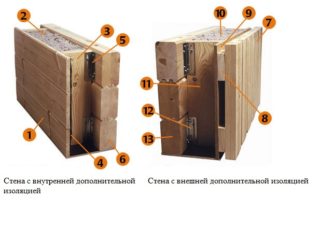
When building according to Finnish technology, insulation with a thickness of up to 100 mm is placed inside the frame made of wood. After that, the frame is sheathed with a bar from the outside and inside. This technology is not widespread enough in Russia due to the lack of the necessary protective materials for waterproofing and vapor barrier. Ventilation in a Finnish house must be clearly organized, otherwise condensation will begin to accumulate inside the walls, which will render them unusable. Without protection from moisture, seals quickly become overgrown with fungi and mold. The presence of even the simplest ventilation system helps to improve the microclimate inside the Finnish frame house.
Norms and requirements
Installation of ventilation systems in private houses should be carried out taking into account the sanitary requirements of GOST 30494-2011. It takes into account such indicators as the temperature of the air, including the total, its speed of movement and the proportion of humidity. Depending on the specified norms, in the calculations it is necessary to apply the permissible or optimal indicators, all of them are presented in Table No. 1 of GOST.
In living rooms, the temperature can fluctuate between 18-24 degrees, the percentage of humidity should be no more than 60%, and the speed of movement of air masses should be 0.2 m / s.
For the kitchen and bathroom, these indicators are equal to 18-26 degrees and 0.2 m / sec., The norms of relative humidity in such rooms are not critical. Proper ventilation in any frame house is installed, including according to the standards of the joint venture. To prevent the formation of condensate, the air ducts are thermally insulated taking into account SP 61.13330. To protect the walls from the inside and outside, special anti-corrosion materials or compounds are used.Installation and commissioning work must be carried out in accordance with the standards of SP 73.13330, this applies to ventilation systems of any type.
The main types of ventilation
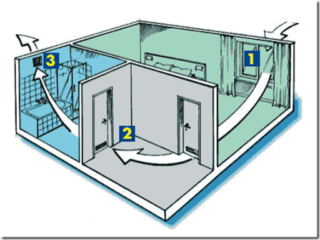
Ventilation in a frame house can be one of the common types, depending on the purpose. Systems are divided into several subgroups, taking into account the direction of movement of air masses, service area, and other factors. They can be supply or exhaust, with natural or mechanical stimulation, general exchange or local.
Natural
This type of ventilation is considered the most popular; in this scheme, air masses are set in motion due to the difference in pressure between the external and internal atmosphere. For this system to work, the street pressure must be lower than the pressure inside the room, after which the air will begin to move through the ventilation ducts. Such channels are installed in the walls of multi-storey and private houses. The main advantage of standard ventilation is its low cost, since the installation of the system does not require large costs.
It is necessary to take into account the dependence of such ventilation on atmospheric parameters. Since movement in the ducts can only take place with a negative pressure difference, if the pressure is equalized, air exchange is automatically interrupted.
The natural ventilation system reacts strongly to changes in weather and precipitation. On frosty days, the draft may be several times less than the calculated one, while in the fall, the movement of air outside begins to affect the interior.
Forced
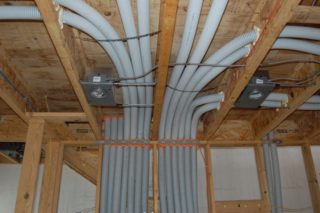
In forced ventilation systems, air movement is carried out by electric energy using fans and supply or exhaust type installations. The main driving element of such a system is a fan, consisting of a housing part, an impeller and an electric motor. The electric motor stimulates the movement of the impeller, made taking into account the capture of air streams and their movement from the intake holes to the exhaust.
Fans can be centrifugal or axial, in the first, the air moves parallel to the blades, and in the second, it passes through the impeller. In addition to the fan in forced systems, additional elements are used: gate valves, air flow regulators, cleaning filters, noise mufflers, air heaters, diffusers, anemostats, grilles, clamps, heaters and other devices in combination with other mounting materials.
Combined
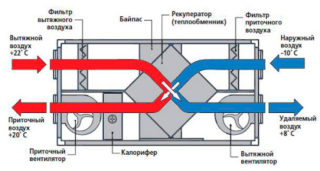
The list of the most popular combined systems includes ventilation of the supply and exhaust type with recuperation. It helps to save energy resources during operation, since the supply and extract air are integrated into one unit that moves both supply and extract air. Two branches must be placed in one device in order to move air flows; at the intersection, recuperators are installed that transfer heat to the supply air from the exhaust air. In some cases, such systems help to save up to 80% of heat and return it back to the room. Rotary or plate recuperators are used for them.
Features and ready-made schemes
It is necessary to choose a specific type of ventilation for a frame house, taking into account financial capabilities, the number of residents and the area of the room as a whole. Due to the non-standard structure, the installation of ventilation ducts in a frame house is possible inside ceilings and walls. In some house projects, special openings for the necessary communications are provided in advance. These are exhaust ducts in which fans can be placed by installing them in the kitchen or in the bathroom, where the air humidity is high.
The list of available schemes includes primitive forced ventilation, exhaust and supply systems, organized and unorganized ventilation options.
Underground ventilation
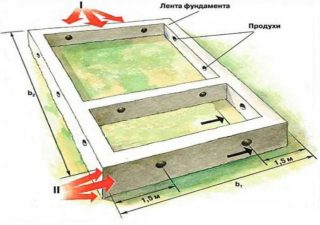
Due to the design features of frame houses, there should be free space between the floors of the first floor and the ground, while it is impossible to equip basements in such buildings. To prevent the accumulation of dampness under the floor and the destruction of the foundation, special holes are formed inside the basement - air vents. They help to ventilate underground rooms and normalize the moisture balance in them. They can be used to eliminate mold, fungi and other microorganisms. A special frame home floor ventilation shaft is also included in the overall air exchange of the whole house.
Step-by-step installation instructions
You can make ventilation in a frame house with your own hands without using special expensive equipment. The installation of the system is carried out in stages using several consecutive steps:
- Equip the supply valves by drilling holes with the required diameter in the walls and floor.
- An air duct pipe is inserted into each of them, supplemented with a grill on the outside and a duct fan on the inside.
- All joints are filled with polyurethane foam, after it has solidified, an air filter and noise-absorbing equipment are placed in the necessary places.
- After the installation of the supply valves, the wiring of the channels is installed, sealing all their fasteners and joints.
- After sewing the channels inside the box and installing decorative trim, the system is checked.
To make a high-quality ventilation system with a hood, it is advisable to develop its scheme and project in advance. It provides for the installation sites of elements on the facade, roof and attic, taking into account the characteristics of a particular structure.








